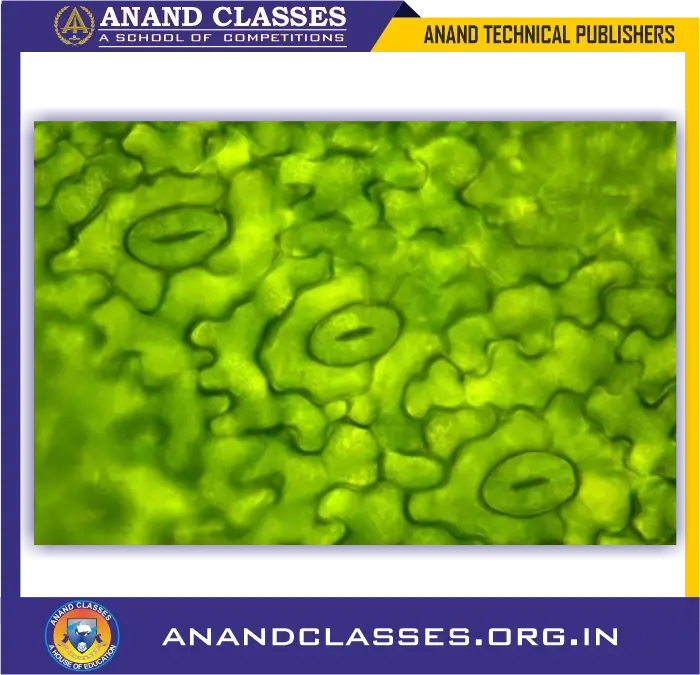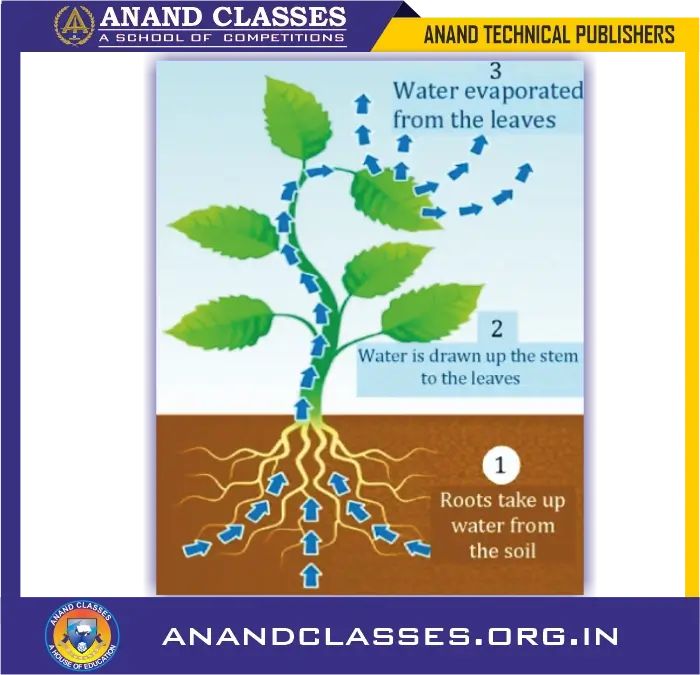ANAND CLASSES Study Material and Notes to learn about the raw materials required for photosynthesis for carbohydrate formation with FAQs, conceptual questions, MCQs, and worksheets for Class 10 Science and NEET Foundation.
Raw Materials Required for Photosynthesis
Photosynthesis is a vital process carried out by green plants to synthesize their own food using sunlight, carbon dioxide, and water. The energy-rich food produced during photosynthesis is essential for plant growth and also forms the base of the food chain for other living organisms. This process primarily occurs in the chloroplasts of leaf cells, which contain the green pigment chlorophyll that captures sunlight.
The preparation of carbohydrates (food) by plants by the process of photosynthesis requires raw materials (or substances). The essential raw materials for photosynthesis include:
- Carbon dioxide (CO2) – Obtained from the atmosphere.
- Water (H2O) – Absorbed from the soil.
- Sunlight – Captured by chlorophyll.
- Minerals and Nutrients – Essential for plant metabolism and growth.
Photosynthesis Process
1. How the Plants Obtain Carbon Dioxide
There are a large number of tiny pores called stomata on the surface of the leaves of plants (The singular of stomata is stoma). Green Plants obtain carbon dioxide from the surrounding air through small openings called stomata, which are primarily found on the surface of leaves for photosynthesis.

(tiny pores) present on the surface of a leaf.
Process of Carbon Dioxide Absorption through Stomata

- Stomatal pores allow the diffusion of carbon dioxide into the leaf.
- Each (stomatal pore) stoma is surrounded by pair of guard cells that control its opening and closing.
- When the plant requires carbon dioxide, the guard cells absorb water, swell up, become curved and open the stomatal pore.
- When the plant wants to conserve water, the guard cells lose water, shrink, become straight and close the pore.
- A large amount of water is also lost from the cells of the plant leaves through open stomatal pores. So, when the plant does not need carbon dioxide and wants to conserve water, the stomatal pores are closed. The oxygen gas produced during photosynthesis also goes out through the stomatal pores of the leaves.
In addition to leaves, the stomata are also present in the green stems (or shoots) of a plant. So, the green stems (or shoots) of a plant also carry out photosynthesis. It is clear from the above discussion that stomata allow the movement of gases in and out of plant cells. In other words, the gaseous exchange in plants takes place through the stomata in leaves (and other green parts).
Key Facts About Stomata
✔️ The oxygen produced during photosynthesis is also released through the stomata.
✔️ In broad-leaved plants, stomata are mainly present on the lower surface of leaves.
✔️ In narrow-leaved plants, stomata are present on both surfaces of the leaf.
✔️ Aquatic plants absorb dissolved carbon dioxide from water instead of using stomata.
✔️ The green stems of some plants also have stomata and can perform photosynthesis.
2. How the Plants Obtain Water for Photosynthesis
Water is absorbed by the roots of the plant from the soil through the process of osmosis and transported to the leaves via specialized plant tissues.

is absorbed by the roots of the plants from the
soil.
Process of Water Absorption and Transport through Roots
- Root hairs absorb water from the soil through osmosis.
- The water moves through the root cortex and reaches the xylem vessels.
- The xylem vessels transport water upwards to the leaves.
- Water reaches the photosynthetic cells in the leaf where it is utilized in photosynthesis.
Other Essential Raw Materials for Photosynthesis
Apart from carbon dioxide and water, plants also require several nutrients from the soil, such as:
- Nitrogen (N) – Essential for protein and enzyme synthesis.
- Phosphorus (P) – Important for DNA and energy transfer.
- Iron (Fe) & Magnesium (Mg) – Required for chlorophyll production.
- Potassium (K) – Helps in enzyme activation and stomatal function.
The plants take up nitrogen from the soil in the form of inorganic salts called nitrates (or nitrites), or in the form of organic compounds which are produced by bacteria from the atmospheric nitrogen.
FAQs (Frequently Asked Questions)
Q1: Why are stomata important for photosynthesis?
A1: Stomata allow carbon dioxide to enter the leaf and oxygen to exit, enabling gas exchange required for photosynthesis.
Q2: What happens if the stomata remain open all the time?
A2: If stomata remain open continuously, the plant will lose excess water through transpiration, leading to dehydration and wilting.
Q3: How does water reach the leaves from the roots?
A3: Water is transported through xylem vessels, which form a continuous pipeline from roots to leaves.
Conceptual Questions with Answers
Q1: How do aquatic plants obtain carbon dioxide for photosynthesis?
A1: Aquatic plants absorb dissolved carbon dioxide from water rather than taking it from the air like terrestrial plants.
Q2: Why do plants need additional nutrients apart from carbon dioxide and water?
A2: Plants require additional nutrients like nitrogen, phosphorus, and magnesium for making proteins, enzymes, and chlorophyll, which are essential for their growth and metabolism.
MCQs with Explanation
- Which part of the plant absorbs water for photosynthesis?
- (a) Leaves
- (b) Stem
- (c) Roots ✅
- (d) Flowers
- Which tissue is responsible for transporting water in plants?
- (a) Phloem
- (b) Xylem ✅
- (c) Guard cells
- (d) Stomata
Do You Know?
- The Amazon Rainforest absorbs large amounts of carbon dioxide, earning it the title “Lungs of the Earth.”
- Some desert plants have sunken stomata to reduce water loss.
- Hydrilla, an aquatic plant, absorbs carbon dioxide directly from water.
- Excess glucose produced in photosynthesis is stored in plants as starch.
Worksheet
- What are the raw materials required for photosynthesis?
- How does carbon dioxide enter the leaves of plants?
- What happens when guard cells shrink?
- How do aquatic plants obtain carbon dioxide for photosynthesis?
- Name two minerals required by plants apart from carbon dioxide and water.
Test Paper (10 Marks)
Section A: Objective Questions (4 Marks)
- Name the raw materials required for photosynthesis. (1 Mark)
- What is the function of guard cells? (1 Mark)
- Which tissue transports water in plants? (1 Mark)
- What is the role of stomata in photosynthesis? (1 Mark)
Section B: Short Answer Questions (3 Marks)
- Explain the process of water absorption in plants. (1.5 Marks)
- How do plants obtain carbon dioxide for photosynthesis? (1.5 Marks)
Section C: Long Answer Question (3 Marks)
- Describe how plants obtain water and carbon dioxide for photosynthesis with the help of diagrams. (3 Marks)
Important Points for Quick Revision
✔️ Photosynthesis requires carbon dioxide, water, sunlight, and chlorophyll.
✔️ Stomata regulate gas exchange, and guard cells control their opening and closing.
✔️ Xylem vessels transport water from roots to leaves.
✔️ Plants also require nutrients like nitrogen, phosphorus, and magnesium for growth.
✔️ Aquatic plants use dissolved carbon dioxide instead of atmospheric CO₂.
✔️ Excess glucose is stored as starch in plants.
🔷 Best Coaching Center for IIT-JEE, NEET, and Foundations
🔹 ANAND CLASSES – The best coaching institute for JEE, NEET, and Class 11-12 Foundations.
🔹 Buy complete study material at 👉 https://publishers.anandclasses.co.in/
🔹 Proprietor: NIRMAL ANAND Educations
🔹 Written by: Neeraj Anand
🔹 Published by: Anand Technical Publishers under Anand Classes
📞 Contact: +91-9463138669
📧 Email: anandclasses1996@gmail.com



